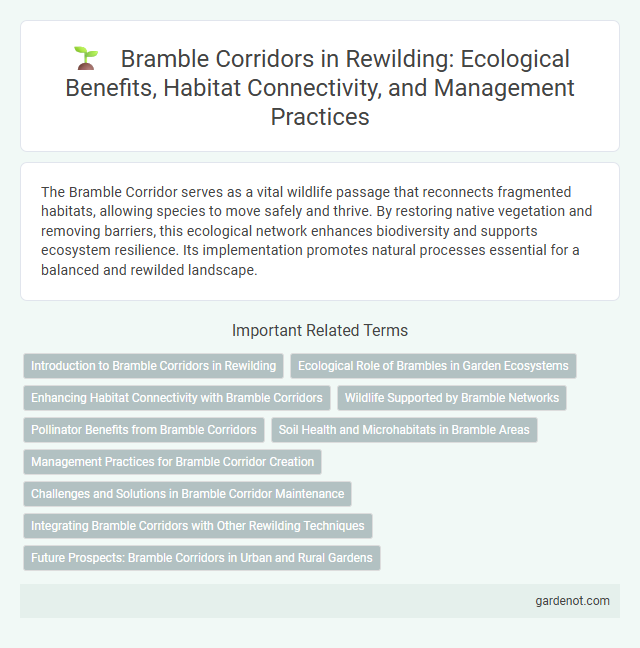The Bramble Corridor serves as a vital wildlife passage that reconnects fragmented habitats, allowing species to move safely and thrive. By restoring native vegetation and removing barriers, this ecological network enhances biodiversity and supports ecosystem resilience. Its implementation promotes natural processes essential for a balanced and rewilded landscape.
Introduction to Bramble Corridors in Rewilding
Bramble corridors play a crucial role in rewilding by providing dense, thorny habitats that support biodiversity and wildlife movement. These natural pathways facilitate connectivity between fragmented ecosystems, allowing species such as birds, insects, and small mammals to thrive and disperse. Incorporating bramble corridors enhances habitat complexity and promotes ecological resilience in rewilded landscapes.
Ecological Role of Brambles in Garden Ecosystems
Bramble corridors serve as vital ecological hubs within garden ecosystems by providing shelter and food for pollinators, birds, and small mammals. Their dense thickets contribute to soil health through leaf litter decomposition and prevent erosion by stabilizing the ground. Supporting biodiversity, brambles facilitate natural pest control and promote the regeneration of native plant species.
Enhancing Habitat Connectivity with Bramble Corridors
Bramble corridors play a vital role in enhancing habitat connectivity by providing continuous shelter and food sources that support wildlife movement across fragmented landscapes. These dense thickets facilitate gene flow among isolated populations, increasing biodiversity and ecosystem resilience. Implementing bramble corridors helps restore natural ecological networks, enabling species to thrive and adapt amid environmental changes.
Wildlife Supported by Bramble Networks
The Bramble Corridor forms a vital habitat network supporting diverse wildlife, including pollinators like bees and butterflies, as well as small mammals and birds that depend on dense thickets for shelter and food. Its dense bramble patches produce abundant berries that serve as a key food source during late summer and autumn, promoting ecological resilience. This corridor enhances biodiversity by connecting fragmented habitats, enabling species migration and genetic exchange essential for sustainable rewilding efforts.
Pollinator Benefits from Bramble Corridors
Bramble corridors provide essential habitats and foraging resources for a diverse range of pollinators, including bumblebees, butterflies, and solitary bees. The dense flowering bramble patches offer abundant nectar and pollen during critical periods when other floral resources are scarce, boosting pollinator health and reproductive success. Enhancing biodiversity through bramble corridors supports ecosystem resilience and promotes effective pollination services in adjacent agricultural and wild landscapes.
Soil Health and Microhabitats in Bramble Areas
Bramble corridors significantly enhance soil health by increasing organic matter and supporting diverse microbial communities that promote nutrient cycling and soil structure. These dense, thorny thickets create vital microhabitats for invertebrates, small mammals, and ground-nesting birds, fostering biodiversity and ecological resilience. The root systems of brambles stabilize soil, reduce erosion, and improve water infiltration, contributing to a balanced and thriving ecosystem in rewilded landscapes.
Management Practices for Bramble Corridor Creation
Management practices for Bramble Corridor creation emphasize native plant restoration, strategic habitat connectivity, and invasive species control to enhance biodiversity. Effective techniques include selective clearing to promote bramble growth, soil enrichment to support native flora, and monitoring wildlife movement to ensure corridor functionality. Regular maintenance and community involvement further sustain corridor health and ecological balance.
Challenges and Solutions in Bramble Corridor Maintenance
Bramble Corridor maintenance faces significant challenges such as invasive species encroachment and habitat fragmentation that threaten native biodiversity. Employing targeted ecological restoration methods like controlled burns and selective pruning fosters habitat connectivity and supports wildlife movement. Continuous monitoring and community-led conservation initiatives enhance the corridor's resilience and long-term ecological health.
Integrating Bramble Corridors with Other Rewilding Techniques
Bramble corridors serve as vital habitat connectors, enhancing biodiversity by linking fragmented ecosystems through dense scrub and thorny vegetation. Integrating bramble corridors with rewilding strategies such as native tree planting, wetland restoration, and natural predator reintroduction promotes ecological resilience and supports diverse wildlife populations. These merged techniques facilitate species migration, improve pollination networks, and accelerate habitat recovery in degraded landscapes.
Future Prospects: Bramble Corridors in Urban and Rural Gardens
Bramble corridors are expected to become vital ecological networks linking fragmented habitats in both urban and rural gardens, promoting biodiversity and supporting pollinators such as bees and butterflies. These corridors facilitate natural wildlife movement, enhancing ecosystem resilience and aiding carbon sequestration by promoting native vegetation growth. Increased community engagement and policy support can further expand bramble corridor initiatives, driving large-scale rewilding efforts across metropolitan and countryside landscapes.
Bramble Corridor Infographic

 gardenot.com
gardenot.com